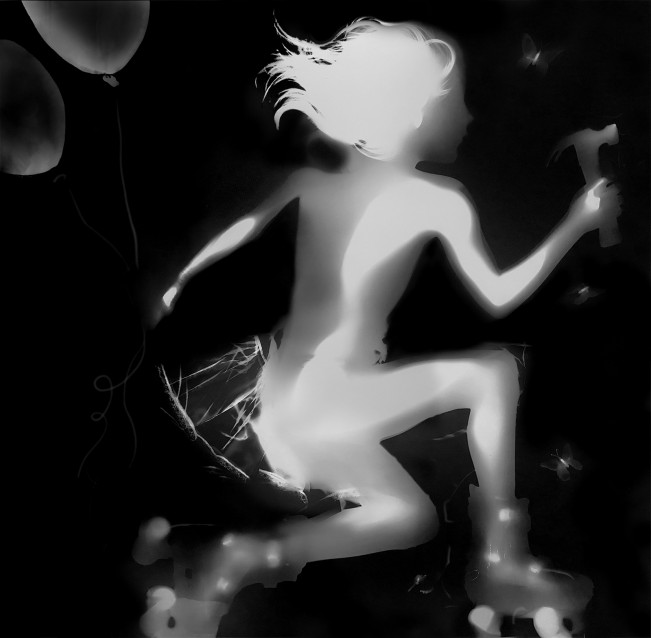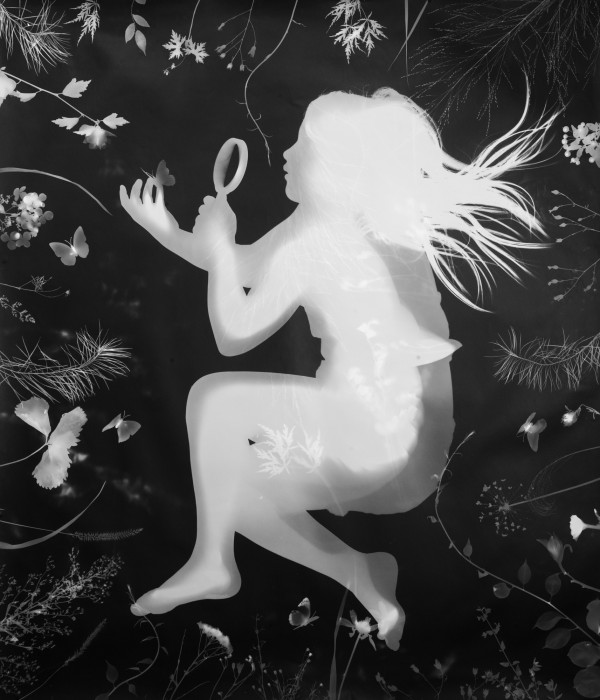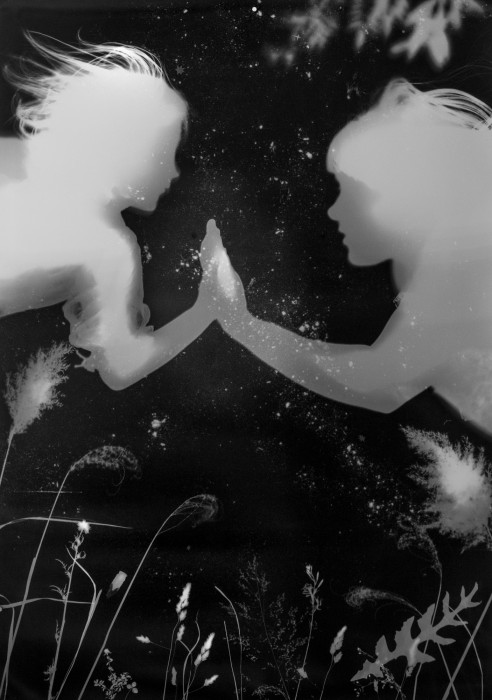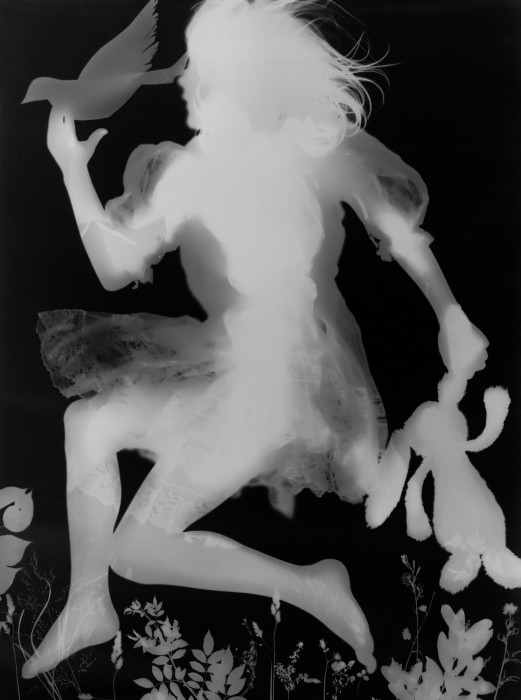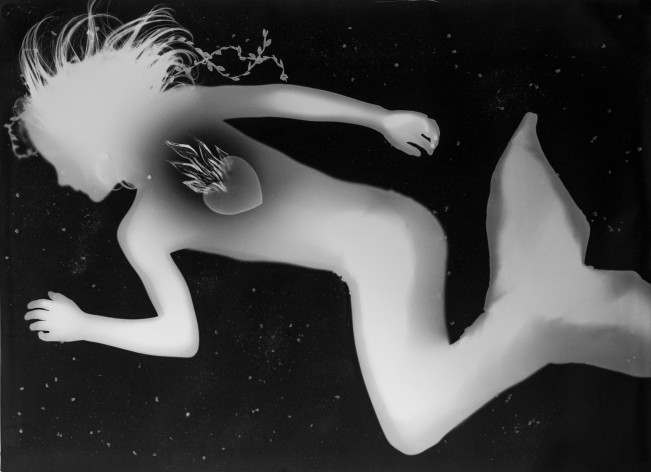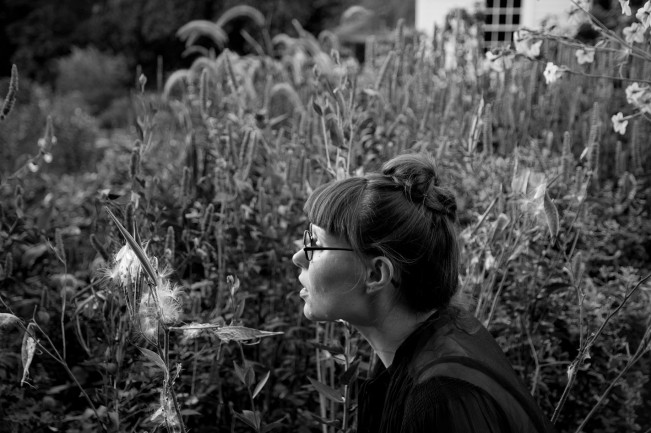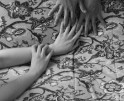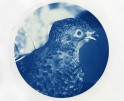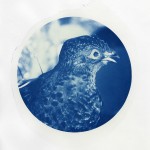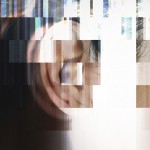Amy Lovera in Conversation with Douglas Breault
Amy Lovera is a lively storyteller whose images percolate with vitality, inventing elements of characters and expressive settings to guide the viewer down the rabbit hole. Lovera is often visible within images, in different iterations or created identities, using self-portraiture to intersect reality and fiction and carve out a space in between where imagination can blossom. Her work feels less like a cinematic image still, and more like a page peeled from a book. Lovera invites the viewer to step inside the plot with just enough information provided to complete the story themselves. In Lovera’s new body of work, she flattens her images to be contained within a monochromatic world by creating silver gelatin photograms with her children. The physicality of arranging the figure and objects directly onto light-sensitive paper creates a direct and immediate connection between Lovera and the surface, leaving ethereal traces of inverted shadows that resist the confines of digital photography.
Making silver gelatin photograms leads to unexpected and serendipitous outcomes, which is where the magic lies. The choreography of objects and movements involves dancing with chance and precision, envisioning the outcome with intuition and patience. The absence of color and certain details tests the boundaries of a photograph’s ability to tell a story in itself. The images have a kinship with drawing, relying upon the boundaries of the forms and the intersection of values to render a world visible in the darkness. Lovera constructs dreamy worlds carved by light. The images share the delicate textures of her children’s hair and clothing that glimmer with a tactile sense of love. The large format prints capture the scale of the child’s form within the boundaries of the paper, containing a complex realm of fearlessness and boundless joy. Considering Lovera’s creative practice as a whole, the photograms are another type of self-portrait, offering the silhouettes of her children as a gentle extension of herself and the beauty of learning to be a curious individual.
An important aspect of your work has always been creating and telling stories, how does the collaboration with your children influence how those stories come together?
My work has always involved reimagining moments from my life or the lives of others. I build photographs rather than take them – often creating props and staging scenes for the camera. My process isn’t that different when I’m working with my children – I sketch and make notes about our experiences, conversations or about the play worlds that my kids create together. If I decide that a sketch will become a photograph, I share it with them and ask for their thoughts. When we are physically making the work in the darkroom, they may have suggestions in the moment that influence the work – an adjustment of a gesture or a different prop. Always, this is for the better. I think it has helped me to not hold on so tightly to the image I have imagined. I am interested in things that can’t be empirically captured with the camera – where hopes, preoccupations and imagination bleed into the everyday. Childhood offers these moments constantly – at once we are tasting mud pies and running from wolves and bandaging scraped knees and driving to basketball practice and asking big questions about the nature of the world.
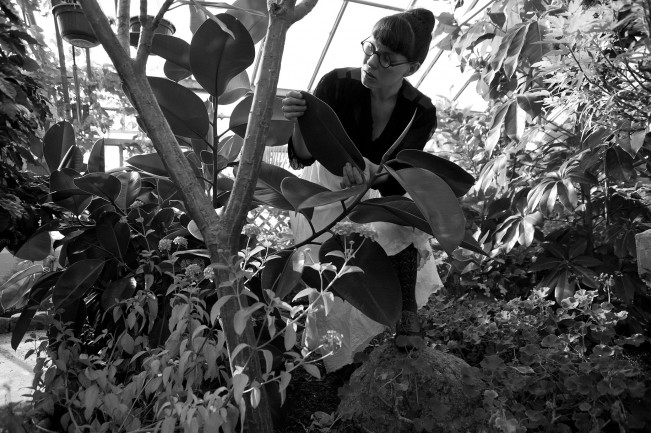
©Amy Lovera, from the series “Anatomy of Wishes”
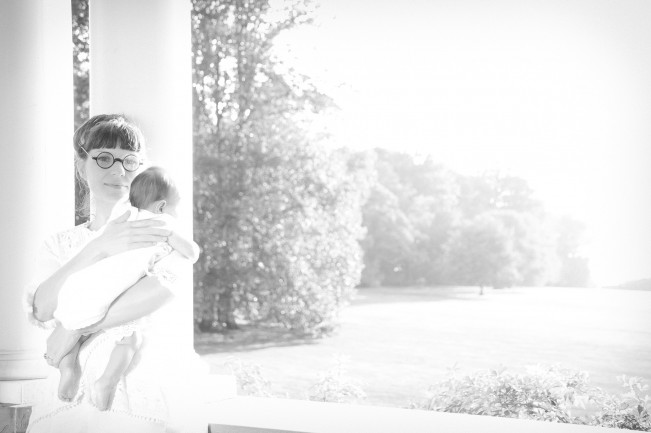
©Amy Lovera, from the series “Anatomy of Wishes”
Is your work more about your personal experience, or do you feel it translates well to other people’s experiences or lives?
This work draws from my personal experiences but more broadly, it is about the transience of childhood from my perspective as a mother. Becoming a parent has profoundly shifted my understanding of time and mortality. This work reflects an urgency to capture and create meaning out of this fleeting time in a way that I hope is relatable. Like Wendy from Peter Pan, I am desperately trying to pin down the shadows of my ever-growing children. In this work, I am investigating what we give to our children in love, experiences and by example: I ask myself what it is I am imprinting upon my children and how this may affect who they grow to be. Much of the work so far has focused on the wonder of childhood; as the work develops, I am hoping to include more “messy” aspects of our lives – moments of sibling conflict and the complexities of parenting
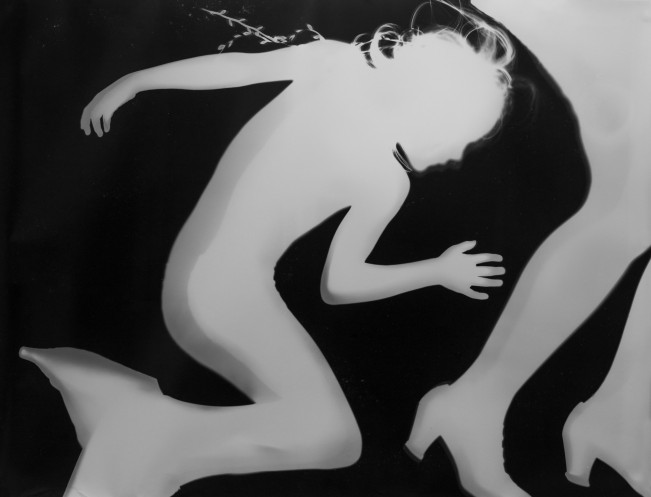
©Amy Lovera, from the series “Securing Shadows”
What advice would you give to someone who wants to take on projects that include members of their family?
First, I would advise them to be patient and kind to themselves. I have been trying to make work with and about my family for many years – and while most of these attempts did not immediately result in finished work, they are informing what I am making now. This has been a slow process but in the bigger picture, 5-10 years is not so long. I remind myself that this is a practice and now that my kids are older, having a consistent practice has become more manageable.
In terms of the physical process of working with my children, I think it’s important that they have agency in their representation, understand and participate in the process. I show them my sketches and I ask them what they think represents them or what we should make pictures about. I also explain how we are going to go about making each picture. I have found that it’s important to not do too much at once – I want my kids to enjoy our time making pictures together. This often means I have to do a lot of experimenting beforehand so that when I am actually working with them in the darkroom, many issues have already been resolved so I’m not constantly problem solving on the spot.
How does the analog process with the photograms affect the outcome differently than using digital photographs?
The process of making these large-scale photograms is very physical and wonderfully unpredictable – so different than working with digital photography! Light-sensitive paper is rolled out onto the floor, and I arrange objects on top – objects that are more translucent will allow light to pass through and render them with interior details while opaque objects will be solid white silhouettes. Working with my body or that of my children or husband, we gently lie on top of the paper while a light is turned on and off to expose the print. This paper is then processed through traditional photographic chemistry.
This project has expanded and renewed my practice. After working with digital photography for many years, I love how this technique reduces photography to its most basic: I am making images out of light and shadow. I am wildly experimenting – exposing the paper multiple times to make images within images, using hand-drawn and digitally printed acetate “negatives” as well as working with cut paper props and a variety of physical objects – plants from our garden, my daughter’s Converse “chucks”, toys, crumbly snacks and the daily love notes my youngest writes me. I have also begun to experiment with manipulating the surface of the final prints, drawing and painting over the images. While I am learning the possibilities of how to control this process, I also love the element of surprise! Light will curve around objects in ways I didn’t expect, some objects are rendered with surprising detail while others are left as ghostly shadows. I love that these are one-of-a-kind images and that they hold the literal impressions of my children at this moment in time. I love too, how they are a record of our collaboration.
Amy Lovera is an artist whose work is rooted in imaginative storytelling and the interplay between reality and fiction. Her narrative works translate personal histories through reenacting them as photographs, animations, drawings and performances. Lovera’s work has been exhibited and published both nationally and internationally, including the Institute of Contemporary Art in Boston, the RISD Museum and a publication in Mexico’s Fine Art Photography journal, Luna Córnea. Lovera is one of this year’s recipients of the Make Art individual artist grant awarded by the Rhode Island State Council of the Arts. She has also been awarded grants from LEF Foundation, Bridgewater State University and RISCA’s Aaron Siskind Fellowship in Photography. She holds an MFA in photography from Rhode Island School of Design with a certificate in collegiate teaching from Brown University. Lovera is an Associate Professor of Photography at Bridgewater State University and makes her home and work in Rhode Island.
Follow Amy Lovera on Instagram: @Amy.lovera
Douglas Breault is an interdisciplinary artist who overlaps elements of photography, painting, sculpture, and video to merge spaces both real and imagined. His work has been collected, published, and exhibited nationally and internationally, including at the Museum of Fine Arts Boston, the Czong Institute for Contemporary Art (South Korea), Space Place Gallery (Russia), the Bristol Art Museum, the Rochester Museum of Fine Arts, Amos Eno Gallery, and VSOP Projects. Breault has been an artist in residence at MassMoca and AS220 and was awarded the Montague Travel Grant to study in London and Paris in 2017. Douglas is a professor of art at Babson College and Bridgewater State University, and he has been a guest critic at MassArt, Wellesley College, Kansas City Art Institute, and the Slade College of Art, among others. Douglas is the Exhibitions Director at Gallery 263 in Cambridge, MA. He received his MFA from the School of the Museum of Fine Arts at Tufts University and a BA in Studio Art from Bridgewater State University, and he currently divides his time between Boston, MA, and Providence, RI.
Follow Douglas Breault on Instagram: @dug_bro
Posts on Lenscratch may not be reproduced without the permission of the Lenscratch staff and the photographer.
Recommended
-
Chelsea Tan: before the light escapes us…July 7th, 2024
-
Josh Raftery: Start the Story at the EndJune 28th, 2024
-
THE CENTER AWARDS: ME&EVE GRANT: ANNA REEDMay 22nd, 2024
-
Earth Week: Casey Lance Brown: KudzillaApril 25th, 2024
-
Earth Month: Photographers on Photographers, Dennis DeHart in conversation with Laura PlagemanApril 16th, 2024

